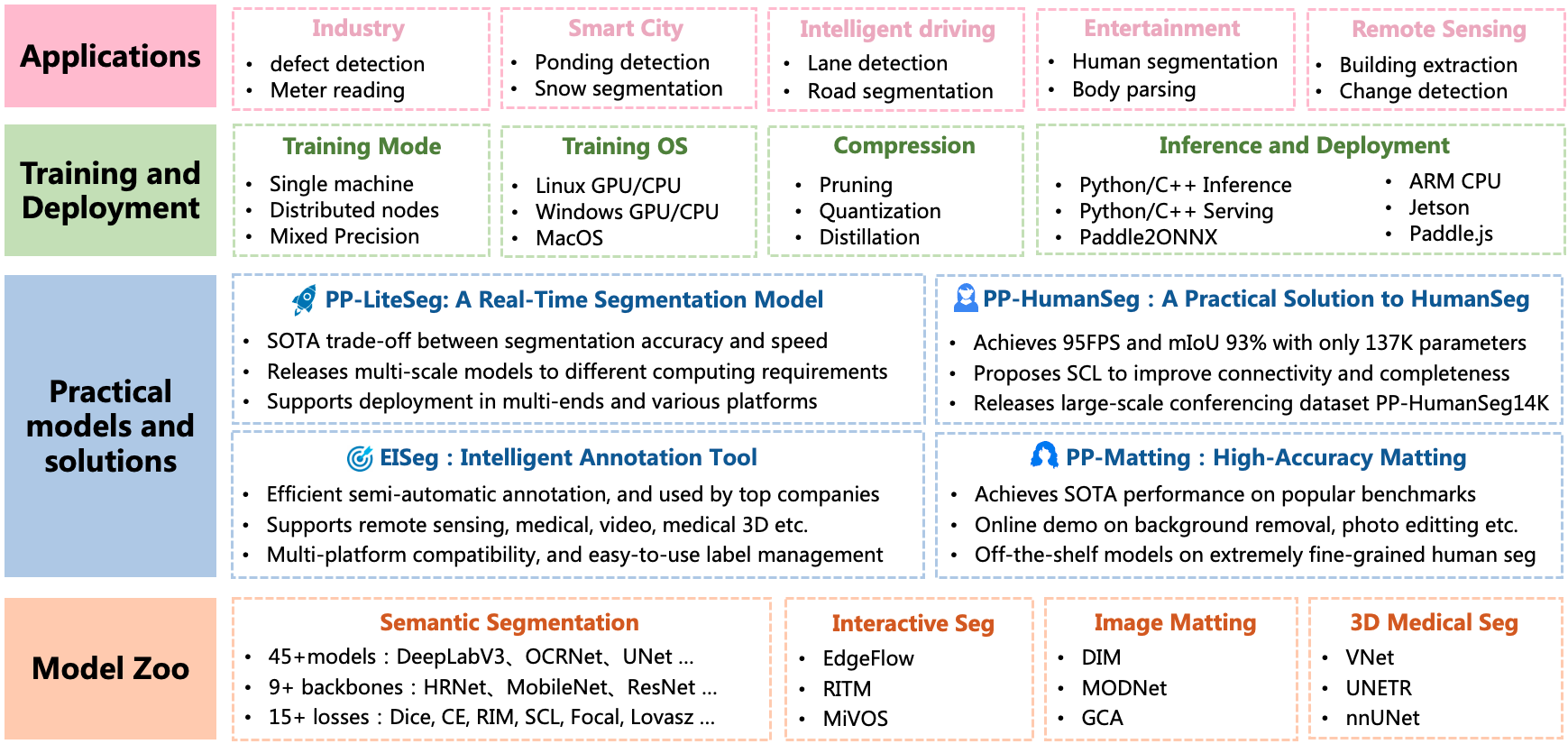English | 简体中文
- [2023-10-29] 🔥 PaddleSeg v2.9 is released! Check more details in Release Notes.
- Support Multi-label segmentation, it procides multi-label segmentation support on a serie of semantic segmetation models.
- Release Mobile SAM, faster version of Segment Anything Model.
- Support Quant Aware Distillation Training Compression for PP-LiteSeg, PP-MobileSeg, OCRNet, and SegFormer-B0 to improve model inference speed.
- [2022-04-11] PaddleSeg v2.8 released Segment Anything Model, an original light-weight semantic segmentation model on mobile devices PP-MobileSeg, QualityInspector v0.5, a full-process solution for industrial quality inspection, and PanopticSeg v0.5, a universal panoptic segmentation solution.
- [2022-11-30] PaddleSeg v2.7 released a real-time human matting model PP-MattingV2, a 3D medical image segmentation solution MedicalSegV2, and a real-time semantic segmentation model RTFormer.
- [2022-07-20] PaddleSeg v2.6 released a real-time human segmentation SOTA solution PP-HumanSegV2, a stable-version semi-automatic segmentation annotation tool EISeg v1.0, a pseudo label pre-training method PSSL, and the source code of PP-MattingV1.
- [2022-04-20] PaddleSeg v2.5 released a real-time semantic segmentation model PP-LiteSeg, a trimap-free image matting model PP-MattingV1, and an easy-to-use solution for 3D medical image segmentation MedicalSegV1.
- [2022-01-20] We release PaddleSeg v2.4 with EISeg v0.4, and PP-HumanSegV1 including an open-sourced dataset PP-HumanSeg14K.
PaddleSeg is an end-to-end high-efficent development toolkit for image segmentation based on PaddlePaddle, which helps both developers and researchers in the whole process of designing segmentation models, training models, optimizing performance and inference speed, and deploying models. A lot of well-trained models and various real-world applications in both industry and academia help users conveniently build hands-on experiences in image segmentation.
-
High-Performance Model: Following the state of the art segmentation methods and using high-performance backbone networks, we provide 45+ models and 150+ high-quality pre-training models, which are better than other open-source implementations.
-
High Efficiency: PaddleSeg provides multi-process asynchronous I/O, multi-card parallel training, evaluation, and other acceleration strategies, combined with the memory optimization function of the PaddlePaddle, which can greatly reduce the training overhead of the segmentation model, all these allowing developers to train image segmentation models more efficiently and at a lower cost.
-
Modular Design: We build PaddleSeg with the modular design philosophy. Therefore, based on actual application scenarios, developers can assemble diversified training configurations with data augmentation strategies, segmentation models, backbone networks, loss functions, and other different components to meet different performance and accuracy requirements.
-
Complete Flow: PaddleSeg supports image labeling, model designing, model training, model compression, and model deployment. With the help of PaddleSeg, developers can easily finish all tasks in the entire workflow.
- If you have any questions, suggestions or feature requests, please do not hesitate to create an issue in GitHub Issues.
- Please scan the following QR code to join PaddleSeg WeChat group to communicate with us:
| Models | Components | Special Cases | |
Semantic SegmentationInteractive SegmentationImage MattingPanoptic Segmentation |
BackbonesLossesMetrics
|
DatasetsData Augmentation
|
Segment AnythingModel Selection ToolHuman SegmentationCityscapes SOTA ModelCVPR Champion ModelDomain Adaptation |
High Accuracy Semantic Segmentation Models
These models have good performance and costly inference time, so they are designed for GPU and Jetson devices.
| Model | Backbone | Cityscapes mIoU(%) | V100 TRT Inference Speed(FPS) | Config File |
|---|---|---|---|---|
| FCN | HRNet_W18 | 78.97 | 24.43 | yml |
| FCN | HRNet_W48 | 80.70 | 10.16 | yml |
| DeepLabV3 | ResNet50_OS8 | 79.90 | 4.56 | yml |
| DeepLabV3 | ResNet101_OS8 | 80.85 | 3.2 | yml |
| DeepLabV3 | ResNet50_OS8 | 80.36 | 6.58 | yml |
| DeepLabV3 | ResNet101_OS8 | 81.10 | 3.94 | yml |
| OCRNet 🌟 | HRNet_w18 | 80.67 | 13.26 | yml |
| OCRNet | HRNet_w48 | 82.15 | 6.17 | yml |
| CCNet | ResNet101_OS8 | 80.95 | 3.24 | yml |
Note that:
- We test the inference speed on Nvidia GPU V100. We use PaddleInference Python API with TensorRT enabled. The data type is FP32, and the shape of input tensor is 1x3x1024x2048.
Lightweight Semantic Segmentation Models
The segmentation accuracy and inference speed of these models are medium. They can be deployed on GPU, X86 CPU and ARM CPU.
| Model | Backbone | Cityscapes mIoU(%) | V100 TRT Inference Speed(FPS) | Snapdragon 855 Inference Speed(FPS) | Config File |
|---|---|---|---|---|---|
| PP-LiteSeg 🌟 | STDC1 | 77.04 | 69.82 | 17.22 | yml |
| PP-LiteSeg 🌟 | STDC2 | 79.04 | 54.53 | 11.75 | yml |
| BiSeNetV1 | - | 75.19 | 14.67 | 1.53 | yml |
| BiSeNetV2 | - | 73.19 | 61.83 | 13.67 | yml |
| STDCSeg | STDC1 | 74.74 | 62.24 | 14.51 | yml |
| STDCSeg | STDC2 | 77.60 | 51.15 | 10.95 | yml |
| DDRNet_23 | - | 79.85 | 42.64 | 7.68 | yml |
| HarDNet | - | 79.03 | 30.3 | 5.44 | yml |
| SFNet | ResNet18_OS8 | 78.72 | 10.72 | - | yml |
Note that:
- We test the inference speed on Nvidia GPU V100. We use PaddleInference Python API with TensorRT enabled. The data type is FP32, and the shape of input tensor is 1x3x1024x2048.
- We test the inference speed on Snapdragon 855. We use PaddleLite CPP API with 1 thread, and the shape of input tensor is 1x3x256x256.
Super Lightweight Semantic Segmentation Models
| Model | Backbone | ADE20K mIoU(%) | Snapdragon 855 Inference latency(ms) | params(M) | Links |
|---|---|---|---|---|---|
| TopFormer-Base | TopTransformer-Base | 38.28 | 480.6 | 5.13 | config |
| PP-MobileSeg-Base 🌟 | StrideFormer-Base | 41.57 | 265.5 | 5.62 | config |
| TopFormer-Tiny | TopTransformer-Tiny | 32.46 | 490.3 | 1.41 | config |
| PP-MobileSeg-Tiny 🌟 | StrideFormer-Tiny | 36.39 | 215.3 | 1.61 | config |
Note that:
- We test the inference speed on Snapdragon 855. We use PaddleLite CPP API with 1 thread, and the shape of input tensor is 1x3x512x512. We test the latency with the final argmax operator on.
| Model | Backbone | Cityscapes mIoU(%) | V100 TRT Inference Speed(FPS) | Snapdragon 855 Inference Speed(FPS) | Config File |
|---|---|---|---|---|---|
| MobileSeg | MobileNetV2 | 73.94 | 67.57 | 27.01 | yml |
| MobileSeg 🌟 | MobileNetV3 | 73.47 | 67.39 | 32.90 | yml |
| MobileSeg | Lite_HRNet_18 | 70.75 | 10.5 | 13.05 | yml |
| MobileSeg | ShuffleNetV2_x1_0 | 69.46 | 37.09 | 39.61 | yml |
| MobileSeg | GhostNet_x1_0 | 71.88 | 35.58 | 38.74 | yml |
Note that:
- We test the inference speed on Nvidia GPU V100. We use PaddleInference Python API with TensorRT enabled. The data type is FP32, and the shape of input tensor is 1x3x1024x2048.
- We test the inference speed on Snapdragon 855. We use PaddleLite CPP API with 1 thread, and the shape of input tensor is 1x3x256x256.
Introductory Tutorials
Basic Tutorials
-
Data Preparation
-
Model Export
-
Model Deployment
Advanced Tutorials
-
Model Compression
Welcome to Contribute
-
Advanced Development
-
Pull Request
- Interactive Segmentation
- Image Matting
- PP-HumanSeg
- 3D Medical Segmentation
- Cityscapes SOTA
- Panoptic Segmentation
- CVPR Champion Solution
- Domain Adaptation
- Using PP-HumanSegV2 for Human Segmentation
- Using PP-HumanSegV1 for Human Segmentation
- Using PP-LiteSeg for Road Segmentation
- Using PaddleSeg for Face Parsing and Makeup
- Using PaddleSeg for Mini-dataset Spine Segmentation
- Using PaddleSeg for Lane Segmentation
- PaddleSeg in APIs
- Learn Paddleseg in 10 Mins
- Application of Interactive Segmentation Technology in Smart Mapping
- Nail art preview machine based on PaddleSeg
- Overrun monitoring of steel bar length based on PaddleSeg
For more examples, see here.
PaddleSeg is released under the Apache 2.0 license.
- Thanks jm12138 for contributing U2-Net.
- Thanks zjhellofss (Fu Shenshen) for contributing Attention U-Net, and Dice Loss.
- Thanks liuguoyu666, geoyee for contributing U-Net++ and U-Net3+.
- Thanks yazheng0307 (LIU Zheng) for contributing quick-start document.
- Thanks CuberrChen for contributing STDC(rethink BiSeNet), PointRend and DetailAggregateLoss.
- Thanks stuartchen1949 for contributing SegNet.
- Thanks justld (Lang Du) for contributing UPerNet, DDRNet, CCNet, ESPNetV2, DMNet, ENCNet, HRNet_W48_Contrast, FastFCN, BiSeNetV1, SECrossEntropyLoss and PixelContrastCrossEntropyLoss.
- Thanks Herman-Hu-saber (Hu Huiming) for contributing ESPNetV2.
- Thanks zhangjin12138 for contributing RandomCenterCrop.
- Thanks simuler for contributing ESPNetV1.
- Thanks ETTR123(Zhang Kai) for contributing ENet, PFPNNet.
If you find our project useful in your research, please consider citing:
@misc{liu2021paddleseg,
title={PaddleSeg: A High-Efficient Development Toolkit for Image Segmentation},
author={Yi Liu and Lutao Chu and Guowei Chen and Zewu Wu and Zeyu Chen and Baohua Lai and Yuying Hao},
year={2021},
eprint={2101.06175},
archivePrefix={arXiv},
primaryClass={cs.CV}
}
@misc{paddleseg2019,
title={PaddleSeg, End-to-end image segmentation kit based on PaddlePaddle},
author={PaddlePaddle Contributors},
howpublished = {\url{https://github.com/PaddlePaddle/PaddleSeg}},
year={2019}
}








